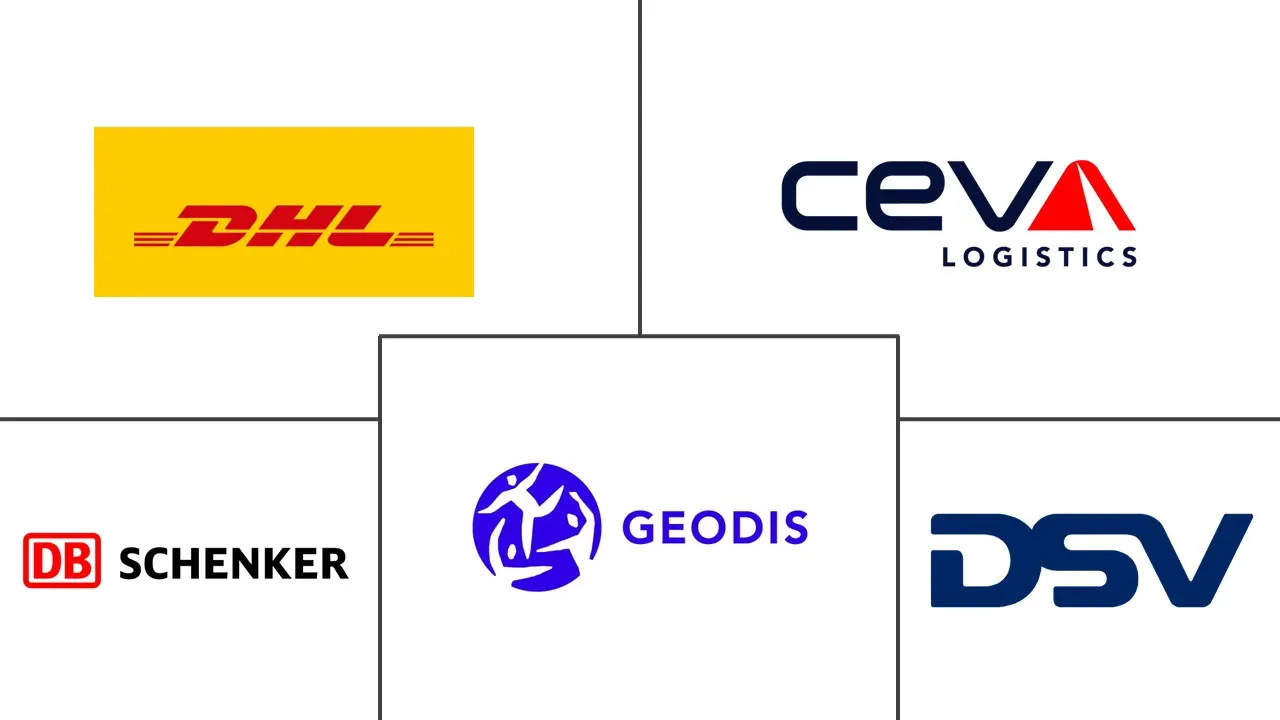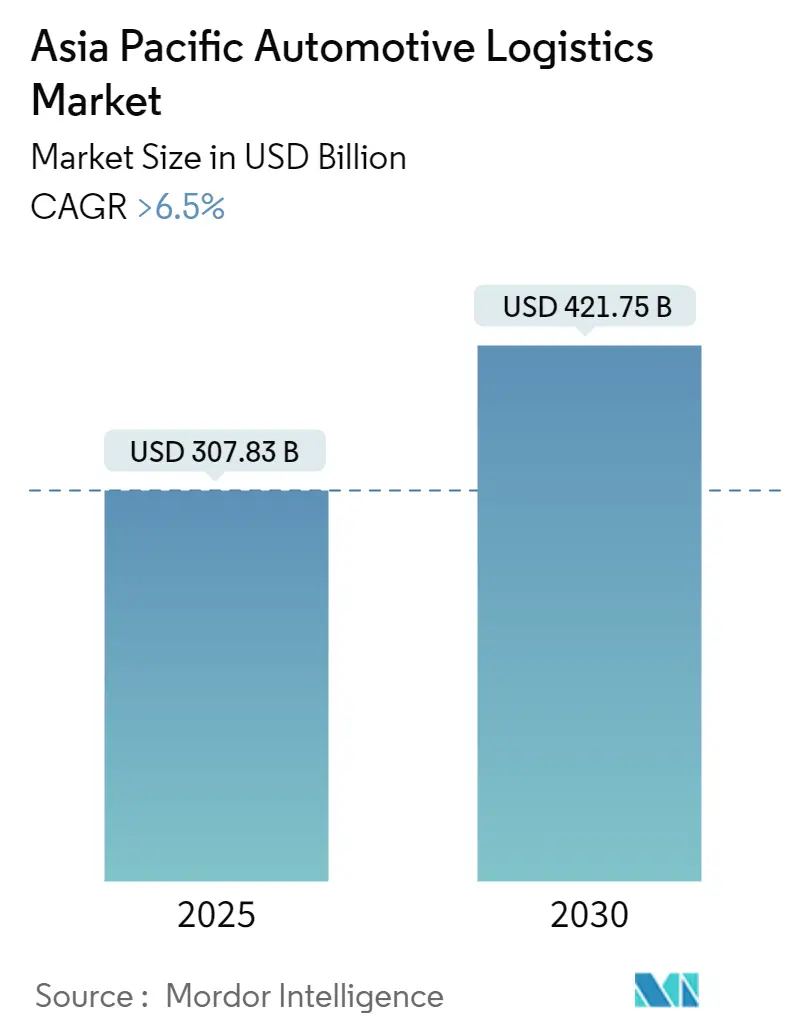
Asia Pacific Automotive Logistics Market Analysis by Mordor Intelligence
The Asia Pacific Automotive Logistics Market size is estimated at USD 307.83 billion in 2025, and is expected to reach USD 421.75 billion by 2030, at a CAGR of greater than 6.5% during the forecast period (2025-2030).
As per the industry analysis, the Asia-Pacific region is estimated to hold the major market share in the global market studied. This is primarily because of the presence of emerging economies like China and India. Numerous factors, like the easy availability of raw materials, increased demand for vehicles in the region, rising population, and availability of low-wage workers, are anticipated to drive the automotive logistics market in the region.
Asia-Pacific is home to some of the major automotive OEM companies, like Toyota, Maruti Suzuki, Hyundai, and SAIC Motor Corporation Limited, among others. With the increasing production and trading activities, there is a demand for logistics companies to manage the procurement, transport, and storage activities of the OEMs to optimize the latter’s supply chain more efficiently.
Global logistics companies are increasingly entering the Asia-Pacific region to tap the growth associated with the market. For instance, in June 2019, French logistics provider GEFCO set up a dedicated subsidiary in Chongqing (China) to specialize in importing and exporting vehicles by rail between Europe, Russia, and China.
Ever-shifting international trade policies, evolving safety and environmental regulations, escalating demand for electronic and autonomous vehicles, changing societal attitudes toward automobiles, global politics, and even cybersecurity issues—all play significant roles in the great auto supply chain.
Various initiatives are undertaken by governmental bodies to accelerate the automotive logistics market further. For instance, in Asia-Pacific, relevant regulations and initiatives to improve professional standards by industry & government play an important role in logistics operations.
The range of logistics services is subject to logistics industry regulations and policies. Moreover, the expansion of such services is also driven by government policies. For instance, the Framework Act on Logistics Policies in Korea provides benefits to companies delivering integrated services of warehousing, transport, and value-added services. The companies entering the automotive logistics market have to comply with multiple entry requirements depending on the type of plan they offer.
Asia Pacific Automotive Logistics Market Trends and Insights
Demand for Electric Vehicles are increasing in the region
The APAC region leads the global electrified vehicle market, accounting for 11.7 million units in 2022, dominated by China. The shift to EVs is forecasted to accelerate due to improvements in battery technology, an expanding network of charging infrastructure, and rising customer demand.
India, which is the fourth largest automotive market in the world, saw a growth of 10% in 2022 on strong underlying demand reflecting the general economic recovery and consumers' preference for personal vehicles over public transportation.
The Indian Government's USD 3.2 billion incentive program, which has drawn USD 8.3 billion in investments, is helping the country's EV and component manufacturing ramp up. To promote the adoption of EVs, Thailand and Indonesia are also improving their policy assistance programs.
During 2022, the sales volume of hybrid EVs in Thailand amounted to almost 42000, the highest among other types of EVs. In 2022, the sales volume of all three types of EVs in Thailand grew by 48%. The Federation of Thai Industries (FTI) predicts that for this year, Thailand’s EV market will continue to gain momentum, with sales expected to reach between 25,000 and 35,000 units.
China's EV market is growing significantly with extensive government support and expansion in charging infrastructure. Increasing government efforts to push electric car sales to up to 25% of the car sales by 2025 have been driving the market growth considerably in China. To achieve the set target, the government has extended the tax exemptions for purchasing electric cars by 2023.
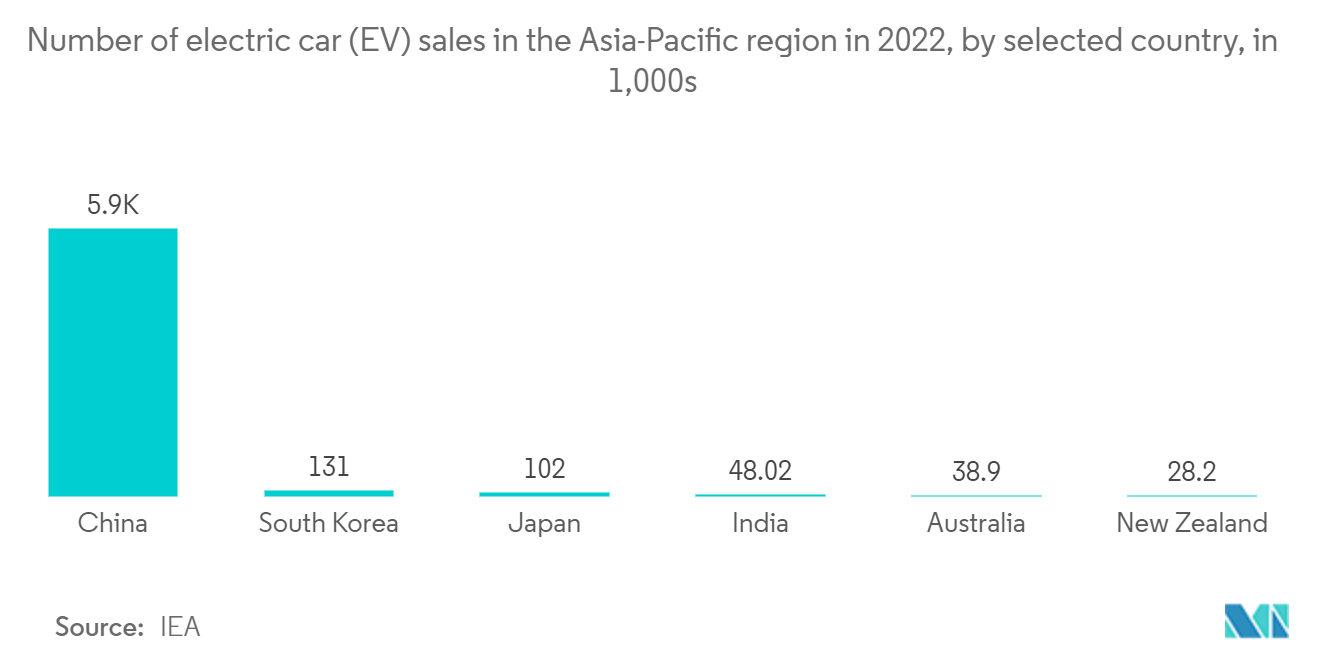
Amalgamation of Smart Technologies and Autonomous Vehicles
Autonomous vehicles are the future of transportation. Conviction reached by several Asian countries, most notably South Korea, China, and Japan, Each is working hard to change the shape of the transport ecosystem by experimenting, legislating, and developing technologies.
South Korea Seoul's metropolitan government has launched the first small-scale self-driving commercial bus service. The trip will be limited to about 3.5 kilometers, during which it will stop at two stations and not carry more than 7 passengers who can reserve their seats through a smart application. The bus will move, which will carry passengers free of charge during the first period, At low speed within a busy tourist and commercial area in the city center. With a budget of nearly USD 900 million, Korea is urging its public and private sectors to achieve its ambition to deploy autonomous vehicles on all its roads by 2026. Among them are 400 buses and taxis.
The Chinese government has amended the traffic safety law; It sets mandatory standards for vehicles on highways and on streets chosen by the local government. It has established a command center that receives information from sensors and cameras distributed across the city to ensure that the system runs as best as possible. Guangzhou, for example, stipulated that the passengers of public buses must be adults and have civilized behavior; it is preparing to deploy 260 self-driving vehicles on its public roads before the end of this year.
The airport in the Japanese capital, After 4 years of preparations, Level IV self-driving buses will begin transporting passengers within the airport facility, Supported by a network of cameras, sensors, and tracking devices, And on lengthy trials of different types of autonomous vehicles traveled about 130,000 kilometers without any incident, The final choice will be made on a 14-passenger bus, It uses GPS and a backup system that regularly scans the road ahead of the bus to take over the drive in case the main system fails. This bus will join 4 cars patrolling the airport perimeter and 12 trolleybuses pulling luggage containers. All of these are battery-powered; it is hoped that its number will double to take over all ground operations by 2030.
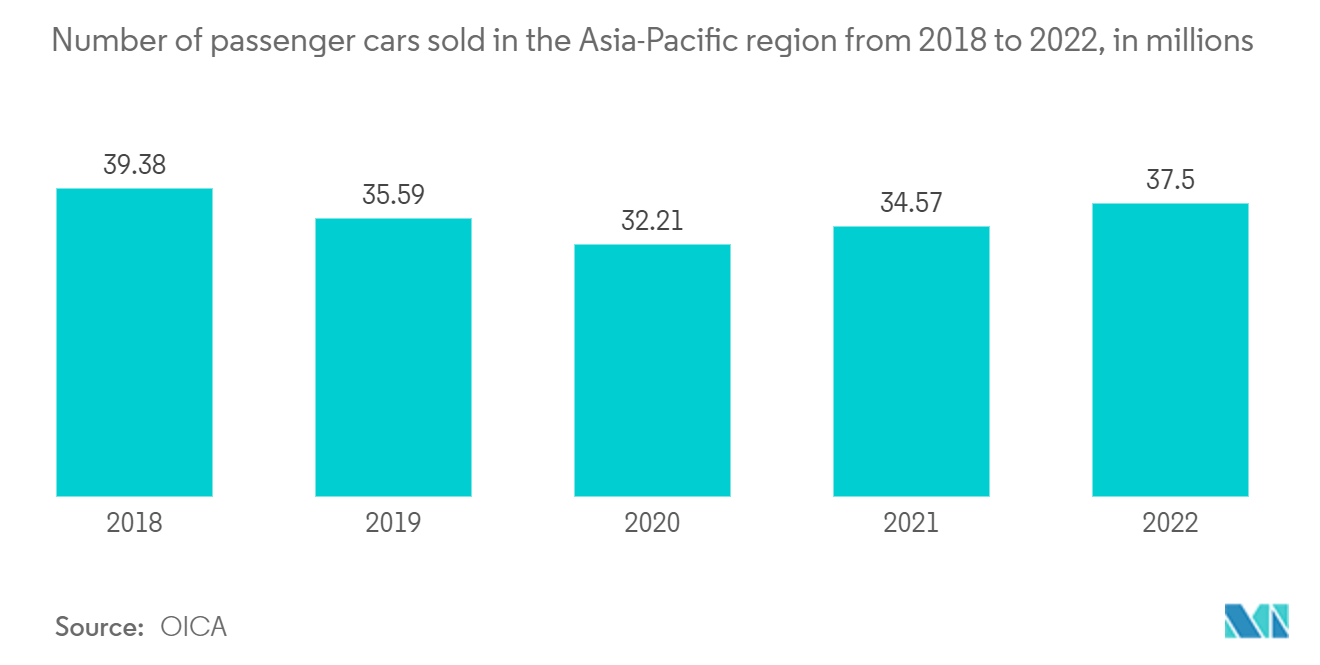
Competitive Landscape
The Asia-Pacific automotive logistics market is fragmented. The market is expected to grow during the forecast period due to the growing demand for electric vehicles, and many other factors are driving the market. International players dominate in the market. Major Players include Kuehne+Nagel International AG, C.H. Robinson Worldwide, Inc., Hellmann Worldwide Logistics, and CEVA Logistics AG.
Asia Pacific Automotive Logistics Industry Leaders
-
Ceva Logistics
-
DB Schenker
-
DHL
-
DSV
-
Geodis
- *Disclaimer: Major Players sorted in no particular order
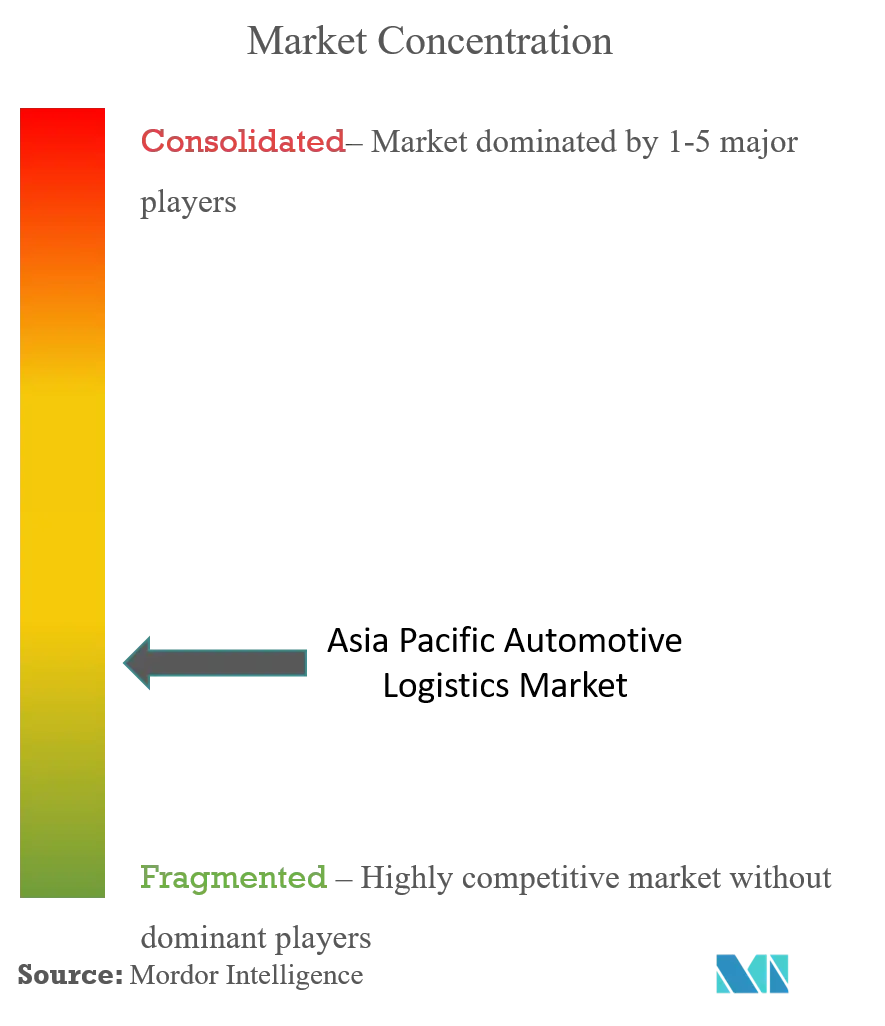
Recent Industry Developments
- March 2023: Tata Motors, One of India’s leading automobile manufacturers and the pioneer of India’s EV evolution, received an order for providing 1000 XPRES-T EVs to OHM E Logistics Pvt. Ltd. in Hyderabad for their electric cab transportation services. These cars will be delivered to OHM E Logistics in a phased manner.
- December 2022: Tata Motors signed a contract with Everest Fleet Pvt. Ltd. for the delivery of 5,000 XPRES-T EVs. The vehicle claims to offer enhanced safety, a fast charging solution, premium interiors, and dynamic performance.
Asia Pacific Automotive Logistics Market Report Scope
Automotive logistics is the meticulous planning and execution of a complicated car transportation process. It covers all modes of transportation, such as rail, truck, and marine.
A complete background analysis of the Asia-Pacific automotive logistics market, which includes an assessment and contribution of the sector in the economy, market overview, market size estimation for key segments, key countries and emerging trends in the market segments, market dynamics, and key component flow statistics are covered in the report. The report also covers the impact of COVID-19 on the market.
The Asia-Pacific automotive logistics market is segmented by service (domestic transportation management, international transport management, warehousing and distribution, value-added services, and others) and by country (India, China, Japan, South Korea, Indonesia, and the Rest of Asia-Pacific).
The report offers the market sizes and forecasts for the Asia-Pacific automotive logistics market in value (USD) for all the above segments.
| Transportation |
| Warehousing, Distribution and Inventory Management |
| Other Services |
| Finished Vehicle |
| Auto Components |
| Other types |
| China |
| India |
| Japan |
| South Korea |
| Indonesia |
| Philippines |
| Rest of Asia-Pacific |
| By Service | Transportation |
| Warehousing, Distribution and Inventory Management | |
| Other Services | |
| By Type | Finished Vehicle |
| Auto Components | |
| Other types | |
| By Country | China |
| India | |
| Japan | |
| South Korea | |
| Indonesia | |
| Philippines | |
| Rest of Asia-Pacific |
Key Questions Answered in the Report
How big is the Asia Pacific Automotive Logistics Market?
The Asia Pacific Automotive Logistics Market size is expected to reach USD 307.83 billion in 2025 and grow at a CAGR of greater than 6.5% to reach USD 421.75 billion by 2030.
What is the current Asia Pacific Automotive Logistics Market size?
In 2025, the Asia Pacific Automotive Logistics Market size is expected to reach USD 307.83 billion.
Who are the key players in Asia Pacific Automotive Logistics Market?
Ceva Logistics, DB Schenker, DHL, DSV and Geodis are the major companies operating in the Asia Pacific Automotive Logistics Market.
What years does this Asia Pacific Automotive Logistics Market cover, and what was the market size in 2024?
In 2024, the Asia Pacific Automotive Logistics Market size was estimated at USD 287.82 billion. The report covers the Asia Pacific Automotive Logistics Market historical market size for years: 2020, 2021, 2022, 2023 and 2024. The report also forecasts the Asia Pacific Automotive Logistics Market size for years: 2025, 2026, 2027, 2028, 2029 and 2030.
Page last updated on:
Asia Pacific Automotive Logistics Market Report
Statistics for the 2025 Asia Pacific Automotive Logistics market share, size and revenue growth rate, created by Mordor Intelligence™ Industry Reports. Asia Pacific Automotive Logistics analysis includes a market forecast outlook for 2025 to 2030 and historical overview. Get a sample of this industry analysis as a free report PDF download.
